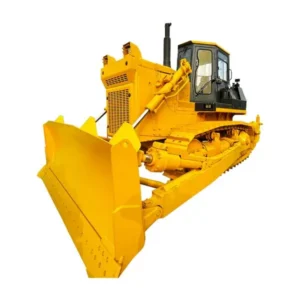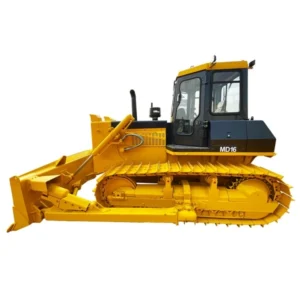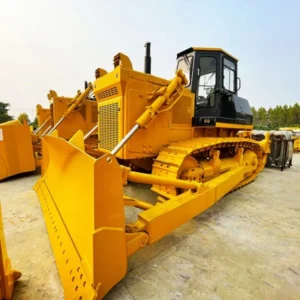Einführung
When it comes to heavy construction and earth-moving equipment, the bulldozer stands out as one of the most powerful and versatile machines. Whether you’re clearing land, moving debris, or grading surfaces, a bulldozer is an indispensable tool on many construction sites. This comprehensive guide aims to answer the question: What is the bulldozer? We will delve into its history, types, key features, applications, and maintenance. By the end of this guide, you’ll have a thorough understanding of what a bulldozer is and how it can be utilized effectively in various projects.
The History of the Bulldozer

Early Developments
The concept of the bulldozer can be traced back to the early 20th century when farmers and construction workers sought more efficient ways to move large amounts of earth. The first bulldozers were modified farm tractors fitted with large blades to push soil.
- 1904: Benjamin Holt invented the first continuous track tractor, which laid the groundwork for future bulldozers.
- 1923: James Cummings and J. Earl McLeod designed the first machine officially recognized as a bulldozer, with a large metal blade in front.
Evolution and Advancements
Over the decades, the bulldozer underwent significant advancements, incorporating new technologies to enhance its power, efficiency, and versatility.
- 1940s: Introduction of hydraulic systems for blade control.
- 1950s-60s: Development of larger, more powerful engines and improved tracks.
- 2000s: Integration of GPS and advanced control systems for precision work.
Types of Bulldozers
Crawler Bulldozers
Crawler bulldozers, also known as track bulldozers, are equipped with tracks instead of wheels. These tracks provide excellent traction, making them ideal for rough, uneven terrain.
- Advantages: Superior traction, stability, and ability to operate in challenging conditions.
- Common Uses: Construction, mining, and forestry.
Wheeled Bulldozers
Wheeled bulldozers have four large tires and are known for their speed and maneuverability. They are often used in projects where mobility and quick repositioning are crucial.
- Advantages: Faster movement, easier to transport, and more maneuverable.
- Common Uses: Road construction, urban projects, and smaller construction sites.
Mini Bulldozers
Mini bulldozers, or compact bulldozers, are smaller in size and are used for light-duty tasks. They are perfect for projects in confined spaces or residential areas.
- Advantages: Compact size, versatility, and ease of use.
- Common Uses: Landscaping, residential construction, and small-scale earthmoving.
Table: Comparison of Bulldozer Types
| Typ | Advantages | Common Uses |
|---|---|---|
| Crawler Bulldozer | Superior traction, stability | Construction, mining, forestry |
| Wheeled Bulldozer | Faster movement, more maneuverable | Road construction, urban projects |
| Mini Bulldozer | Compact size, versatility | Landscaping, residential construction |
Key Features of Bulldozers
Blade Types and Functions
The blade is the most prominent feature of a bulldozer. Different types of blades are designed for various tasks:
- Straight Blade (S-Blade): Used for fine grading and leveling.
- Universal Blade (U-Blade): Designed for moving heavy materials over long distances.
- S-U Blade (Semi-U Blade): A combination of S-Blade and U-Blade, used for pushing piles of debris.
- Angle Blade: Can be angled to the left or right, used for pushing materials to the side.
Tracks vs. Wheels
The choice between tracks and wheels significantly impacts a bulldozer’s performance:
- Tracks: Provide better traction and stability on uneven terrain.
- Wheels: Offer better mobility and speed on flat surfaces.
Engine Power and Performance
A bulldozer’s engine power determines its ability to perform heavy-duty tasks. Modern bulldozers are equipped with powerful engines that provide the necessary force to move large amounts of material.
- Horsepower: Varies from 80 HP for smaller models to over 500 HP for large bulldozers.
- Fuel Efficiency: Modern engines are designed to be more fuel-efficient, reducing operating costs.
Hydraulische Systeme
Hydraulic systems are essential for controlling the blade and other attachments. They provide the necessary force to lift, tilt, and angle the blade with precision.
- Blade Control: Allows for precise movements and adjustments.
- Attachment Versatility: Supports a variety of attachments for different tasks.
Applications of Bulldozers
Konstruktion
Bulldozers are a staple in the construction industry, used for a variety of tasks including site preparation, grading, and debris removal.
- Site Preparation: Clearing land and leveling the ground.
- Grading: Ensuring a flat and even surface for construction.
- Debris Removal: Moving construction waste and debris.
Bergbau und Steinbrüche
In mining and quarrying, bulldozers are used to clear overburden, level surfaces, and transport materials.
- Overburden Removal: Clearing the topsoil and rocks to access minerals.
- Leveling: Preparing sites for mining operations.
- Material Transport: Moving extracted materials to processing areas.
Forestry
In forestry, bulldozers are used for road construction, site preparation, and clearing land for new growth.
- Road Construction: Building access roads for logging operations.
- Site Preparation: Clearing land for planting new trees.
- Fire Breaks: Creating fire breaks to prevent the spread of wildfires.
Landwirtschaft
Bulldozers are also used in agriculture for land clearing, building terraces, and constructing ponds.
- Land Clearing: Removing trees and brush for farming.
- Terracing: Creating terraces to prevent soil erosion.
- Pond Construction: Building ponds for irrigation and livestock.
Military
The military uses bulldozers for constructing fortifications, clearing obstacles, and building roads in challenging environments.
- Fortifications: Constructing defensive structures.
- Obstacle Clearing: Removing obstacles for troop movements.
- Road Building: Constructing roads in remote areas.
Maintenance of Bulldozers

Regelmäßige Inspektionen
Regular inspections are crucial to ensure that bulldozers remain in optimal working condition. This includes checking the engine, hydraulics, tracks or tires, and blade.
- Engine Checks: Inspect for oil leaks, check fluid levels, and ensure proper operation.
- Hydraulic System: Check for leaks and ensure all components are functioning properly.
- Tracks/Tires: Inspect for wear and tear, and replace if necessary.
- Klinge: Ensure it is securely attached and free from damage.
Lubrication
Proper lubrication of moving parts is essential to reduce friction and prevent wear. This includes the engine, hydraulic components, and tracks or tires.
- Engine Oil: Regularly check and replace engine oil.
- Hydraulic Fluid: Maintain proper levels and replace as needed.
- Track/Tire Lubrication: Ensure tracks or tires are properly lubricated to reduce wear.
Cleaning
Regular cleaning of the bulldozer helps prevent the buildup of dirt and debris, which can cause damage over time.
- Exterior Cleaning: Remove dirt and debris from the exterior surfaces.
- Undercarriage Cleaning: Ensure the undercarriage is free from mud and debris.
- Cabin Cleaning: Keep the operator’s cabin clean for comfort and safety.
Scheduled Maintenance
Follow the manufacturer’s recommended maintenance schedule to ensure all components are inspected and serviced regularly.
- Routine Servicing: Follow the manufacturer’s guidelines for routine servicing.
- Component Replacement: Replace worn or damaged components as needed.
- System Checks: Perform regular checks of all systems to ensure proper operation.
Conclusion: what is the bulldozer?
Understanding what a Bulldozer is and how it functions is essential for anyone involved in construction, mining, forestry, agriculture, or military operations. This comprehensive guide has explored the history, types, key features, applications, and maintenance of bulldozers, providing valuable insights into their importance and versatility. By following proper maintenance practices and selecting the right type of bulldozer for your specific needs, you can ensure optimal performance and longevity of this powerful machine.
FAQ
What is the bulldozer primarily used for?
A bulldozer is primarily used for moving large amounts of earth, debris, or other materials. It is equipped with a large blade that can push, grade, and clear land, making it essential for construction, mining, forestry, agriculture, and military operations.
What is the bulldozer’s main component that differentiates it from other heavy machinery?
The main component that differentiates a bulldozer from other heavy machinery is its large blade. The blade is designed to push and move materials, which is central to the bulldozer’s function in various earthmoving and clearing tasks.
What is the bulldozer’s role in the construction industry?
In the construction industry, the bulldozer’s role includes site preparation, grading, and debris removal. It clears land, levels surfaces, and moves construction materials, making it a versatile and essential piece of equipment.
What is the bulldozer’s advantage over wheeled machinery on rough terrain?
The bulldozer’s advantage over wheeled machinery on rough terrain is its tracks. The tracks provide superior traction and stability, allowing the bulldozer to operate efficiently on uneven and soft ground where wheeled machinery might struggle.
What is the bulldozer’s blade, and what types are available?
The bulldozer’s blade is a large, heavy metal plate at the front of the machine used for pushing materials. Types of blades available include the straight blade (S-blade) for fine grading, the universal blade (U-blade) for moving heavy materials, the semi-U blade (S-U blade) for pushing debris, and the angle blade for pushing materials to the side.
What is the bulldozer’s role in mining operations?
In mining operations, the bulldozer’s role includes clearing overburden, leveling surfaces, and transporting materials. It is used to prepare mining sites, move extracted minerals, and maintain haul roads.
What is the bulldozer’s function in the agricultural sector?
In the agricultural sector, the bulldozer’s function includes land clearing, building terraces, and constructing ponds. It helps in removing trees and brush, preventing soil erosion, and creating water storage areas for irrigation and livestock.
What is the bulldozer’s significance in military applications?
In military applications, the bulldozer’s significance lies in its ability to construct fortifications, clear obstacles, and build roads in challenging environments. It is used for creating defensive structures, removing debris, and ensuring safe passage for troops and vehicles.
What is the bulldozer’s maintenance requirement to ensure optimal performance?
To ensure optimal performance, the bulldozer’s maintenance requirements include regular inspections, proper lubrication of moving parts, routine cleaning, and following the manufacturer’s recommended maintenance schedule. Regularly checking the engine, hydraulics, tracks or tires, and blade is essential.
What is the bulldozer’s impact on project efficiency and cost-effectiveness?
The bulldozer’s impact on project efficiency and cost-effectiveness is significant due to its ability to perform multiple tasks quickly and effectively. It reduces the need for additional machinery, lowers labor costs, and enhances overall productivity on construction and earthmoving projects.








-150x150.webp)
